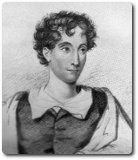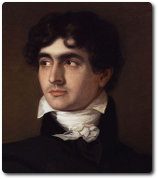Christina Rossetti, selected poems Contents
- Social / political context
- Religious / philosophical context
- Literary context
- A Better Resurrection
- A Birthday
- A Royal Princess
- At Home
- Cousin Kate
- Despised and Rejected
- Echo
- Goblin Market
- Good Friday
- Jessie Cameron
- L.E.L
- Maude Clare
- Remember
- Shut Out
- Song (When I am dead, my dearest)
- Summer is Ended
- The Convent Threshold
- The Lowest Place
- To Lalla, reading my verses topsy-turvy
- Twice
- Up-hill
- Winter: My Secret
Gothic literature
Origins and background
The term ‘Gothic' originally refers to the Goths, an ancient Germanic people and then came to mean ‘related to a style of architecture of the twelfth-sixteenth centuries'. However, in literature it is usually associated with an aspect of the English Romantic movement and especially with the renewed interest of that time (late eighteenth to mid-nineteenth century) in all things medieval.
In literature, the taste for medievalism was constantly indulged, especially its association with the strange, the weird and the exotic. The work which is generally considered to be the forerunner of the vogue for the ‘Gothic horror' novel in Britain is Horace Walpole's The Castle of Otranto. This was published in 1765, ostensibly as a translation of a medieval tale. It is set in medieval time, in a strange, gloomy and haunted castle in Italy. Walpole unashamedly makes fantastical and imaginative use of the supernatural, which was to become a feature of Gothic novels. This was in itself a reaction against the emphasis in much late-seventeenth to mid-eighteenth century writing on the importance of reason. The Castle of Otranto is riddled with dark vaults, subterranean passages, trap-doors, caverns – and ghosts (for more detailed information see Critical approaches to literature > Gothic and the medieval revival).
Charles Robert Maturin
 Rossetti's early writings were very much influenced by the Gothic fiction she read as a child. She was particularly influenced by the novels of Charles Robert Maturin and several of her early unpublished poems include characters that he created.
Rossetti's early writings were very much influenced by the Gothic fiction she read as a child. She was particularly influenced by the novels of Charles Robert Maturin and several of her early unpublished poems include characters that he created.
In Maturin's The Fatal Revenge, Rosalia is torn between romantic and spiritual love, choosing to run away from the convent in which she is placed. The women Rossetti portrays in The Novice, Three Nuns, The Convent Threshold and Soeur Louise de la Misericorde, echo Rosalia's struggles as she tries to overcome romantic love.
Maturin's 1820 novel, Melmoth the Wanderer, was a particular influence on Rossetti's use of Gothic tropes and descriptions of the supernatural. In 1848, when she was 18, she wrote a poem she entitled Isidora:
- This was based directly on the central female character of Melmoth the Wanderer
- Rossetti's poem follows the narrative of the novel, emphasising the difficulty of reconciling a love of God with love for another being
- In the last line of the poem, Isidora asks Christ whether ‘he' (Melmoth), will ‘be there' (in Paradise). The line is taken directly from Maturin's narrative of Isidora's death.
Maturin's image of the bride is transposed and subverted by Rossetti in her poem, Look on this Picture and on This. Based directly based on Maturin's novel, Women, Rossetti speaks of the main character Eva as ‘glorified in white', having been transformed through her patience. Between 1847 and 1856, Rossetti wrote four other poems based around incidents given in Maturin's novel, Women. Rossetti also wrote poems based on Maturin's The Wild Irish Boy.
John William Polidori
 Rossetti's maternal uncle, John William Polidori, was the creator of the vampire genre in literature. His novella, The Vampyre, was published in 1819 and has at its centre a vampire nobleman.
Rossetti's maternal uncle, John William Polidori, was the creator of the vampire genre in literature. His novella, The Vampyre, was published in 1819 and has at its centre a vampire nobleman.
As Byron's physician and friend, Polidori was involved in the ‘competition' which led to the writing of Mary Shelley's Frankenstein (see Frankenstein > How Frankenstein came to be written). Suffering from depression, Polidori died in mysterious circumstances in 1821. It is likely that this, along with the fact that he had been close to the notorious celebrity Byron, caused his family shame and accounts for Rossetti's silence regarding her uncle's work.
Ann Radcliffe
.jpg) In 1883, Rossetti re-read Ann Radcliffe's novels, since she was preparing to write a biography of her life. Although this plan never actually materialised, several characteristic images included in Radcliffe's novels such as The Mysteries of Udolpho (1794) and The Italian (1796) are employed throughout Rossetti's poetry. The images of masks, secrets and ghosts are used to emphasise elements of the supernatural with which Rossetti was concerned.
In 1883, Rossetti re-read Ann Radcliffe's novels, since she was preparing to write a biography of her life. Although this plan never actually materialised, several characteristic images included in Radcliffe's novels such as The Mysteries of Udolpho (1794) and The Italian (1796) are employed throughout Rossetti's poetry. The images of masks, secrets and ghosts are used to emphasise elements of the supernatural with which Rossetti was concerned.
Recently Viewed
Scan and go
Scan on your mobile for direct link.